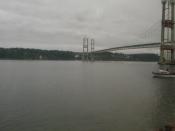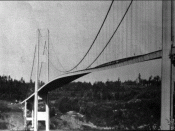Tacoma Narrows Bridge
The Tacoma Narrows is the single point in the 20,000 square miles of Puget Sound where the Washington mainland and the Olympic Peninsula are close. For years, it had been clear to State officials that the Narrows would have to be bridged in order to open up the spectacular and thinly populated Peninsula. Aware of this situation, the Washington State Legislature created the Washington Toll Bridge Authority in 1937, with a mandate to finance, construct and operate toll bridges.
The first Tacoma Narrows Bridge was revolutionary in its design and historic in its collapse. The failure on November 7, 1940 marked the end of a trend in bridge engineering towards a maximum of lightness, grace and flexibility. Since the turn of the century, suspension bridge construction valued structural grace and slenderness to achieve an artistic appearance. With its shallow stiffening trusses and slender towers, the bridge across the Narrows was the epitome of artistry in bridge construction.
The Tacoma Narrows Bridge was known for its tendency to sway in windstorms. The shape of the bridge was much like that of an aircraft wing and under windy conditions it would generate sufficient lift and become unstable. On November 7, 1940 a large windstorm caused severe and catastrophic failure if the bridge deck.
The original, 5,939-foot-long Tacoma Narrows Bridge, popularly known as "Galloping Gertie," opened to traffic on July 1, 1940 after two years of construction, linking Tacoma and Gig Harbor. It collapsed just four months later during a 42-mile-per-hour wind storm on Nov. 7, 1940.
The bridge earned the nickname "Galloping Gertie" from its rolling, undulating behavior. Motorists crossing the 2,800-foot center span sometimes felt as though they were traveling on a giant roller coaster, watching the cars ahead disappear completely for a few moments as if they...


